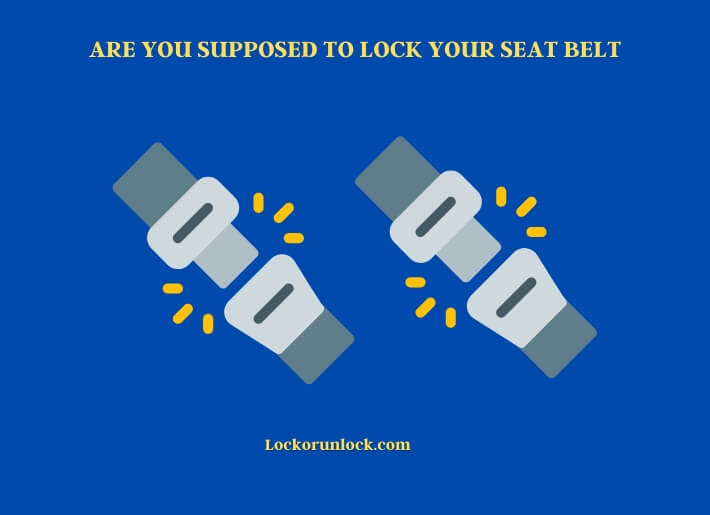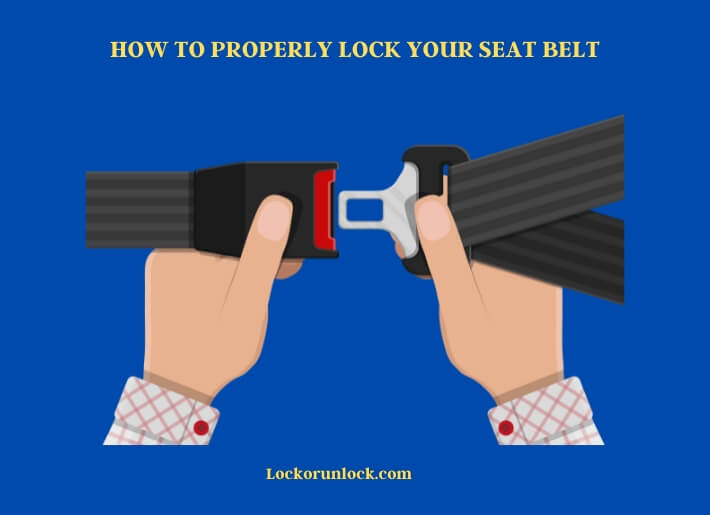Seat belts are a critical component of vehicle safety, designed to protect occupants in the event of a crash by preventing them from being ejected or thrown around inside the vehicle. They are proven to be highly effective in reducing the risk of serious injuries and fatalities. However, there are still misconceptions and questions about seat belt usage, including whether you should lock your seat belt. Some may wonder if locking the seat belt is necessary or if it makes a difference in terms of safety.

Seat Belt Mechanisms
Seat belts are intricate safety devices that are specifically designed to protect passengers in a vehicle. They work using various mechanisms that ensure proper restraint during a collision, reducing the risk of injuries or fatalities. It’s essential to have a clear understanding of how seat belts work to ensure that you are using them correctly for maximum safety.
Types of Seat Belts
There are different types of seat belts commonly used in vehicles. These include lap belts, shoulder belts, and combination belts. Lap belts are designed to secure the passenger’s hips and prevent them from sliding forward during a crash.
Shoulder belts, also known as three-point belts, add a layer of protection by restraining the upper body and preventing it from moving forward or sideways. Combination belts have both lap and shoulder belts integrated into a single system. It’s crucial to use the type of seat belt that is designed for the specific seating position and follow the manufacturer’s instructions for proper usage.
Seat Belt Retractors
Seat belts are equipped with retractors, which are mechanisms that control the amount of slack or tension in the seat belt webbing. There are two main types of seat belt retractors: emergency locking retractors (ELR) and automatic locking retractors (ALR). ELRs lock the seat belt only during sudden deceleration or impacts, while ALRs lock the seat belt when pulled out to its full length. These retractors play a crucial role in keeping the seat belt snug and maintaining proper tension during a crash, preventing the occupant from being thrown forward or out of the vehicle.
Seat Belt Locking Mechanisms
Some seat belts also have additional locking mechanisms that can be engaged for specific purposes, such as child safety seats or booster seats. These mechanisms allow the seat belt to be locked in place without relying solely on the retractor. They ensure that the seat belt remains securely tightened and provides the highest level of protection for the occupant, especially in the case of vulnerable passengers like children.
Seat Belt Pretensioners
Some modern vehicles are also equipped with seat belt pretensioners, which are devices that retract the seat belt webbing rapidly during a crash. This action removes any slack from the seat belt and pulls the occupant back into the seat, minimizing the risk of injuries caused by excessive forward movement.
How to Properly Lock Your Seat Belt
Using a seat belt correctly is crucial to ensure its effectiveness in protecting you during a crash. Here are the steps to properly lock your seat belt:

Buckle Up
Start by buckling the seat belt across your lap and shoulder, making sure it is securely fastened. The lap portion of the seat belt should fit snugly across your hips, while the shoulder portion should come across your chest and shoulder without any twists or slack.
Adjust the Seat Belt
Adjust the seat belt to fit you properly. Most modern vehicles have adjustable seat belts that can be tailored to your body size and shape. Pull the shoulder portion of the seat belt to remove any slack and ensure a snug fit. The lap portion should be positioned low on your hips, avoiding any soft areas like your stomach.
Lock the Seat Belt
Many seat belts have a locking mechanism that prevents them from extending freely in certain situations, such as during sudden stops or impacts. To engage the locking mechanism, pull the seat belt slowly and firmly until it is fully extended. Then, let the seat belt retract slowly while keeping tension on it. This will activate the locking mechanism, ensuring that the seat belt stays snugly in place.
Check for Proper Fit
Once the seat belt is locked, check again to make sure it fits properly. The seat belt should be tight against your body with no slack, but it should not be too tight to cause discomfort or restrict your movement. You should be able to fit two fingers between your body and the seat belt.
Avoid Common Mistakes
It’s important to avoid common mistakes that can compromise the effectiveness of your seat belt. Never tuck the shoulder portion of the seat belt behind your back or under your arm, as this can cause serious injuries during a crash. Also, make sure the seat belt is not twisted and that it is properly latched in the buckle.
Follow Vehicle and Local Regulations
Always follow the manufacturer’s instructions for your specific vehicle and local regulations regarding seat belt usage. Different vehicles may have different seat belt mechanisms and instructions, so it’s important to familiarize yourself with the specific features of your vehicle and follow any local laws or regulations regarding seat belt usage.
Proper Seat Belt Usage
Using seat belts correctly is paramount to ensuring their effectiveness in protecting vehicle occupants in the event of a crash. Here are some key guidelines for proper seat belt usage:
Wear the Seat Belt at all Times: It’s crucial to wear your seat belt at all times while inside a moving vehicle, whether you are the driver or a passenger. Make sure that all passengers in the vehicle, including those in the back seat, are wearing their seat belts as well. Seat belts should be fastened before the vehicle starts moving, and they should remain fastened throughout the entire trip.
Adjust the Seat Belt Properly: The seat belt should be positioned correctly to provide optimal protection. The lap belt should be positioned low and snug across the hips, and the shoulder belt should cross the middle of the chest and rest on the shoulder without cutting into the neck. Avoid placing the shoulder belt behind your back or under your arm, as this can reduce its effectiveness and increase the risk of injuries in a crash.
Engage All Available Locking Mechanisms: If your seat belt has additional locking mechanisms, such as the locking clip for child safety seats, or the seat belt locking mode for securing booster seats, make sure to engage them according to the manufacturer’s instructions. These mechanisms help to ensure that the seat belt remains securely tightened during a crash, providing the highest level of protection for all occupants.
Avoid Twisting or Tangling of Seat Belts: Seat belts should be free from any twists or tangles that could affect their performance. Make sure that the seat belt webbing is not twisted and that it lays flat against your body. Twisted or tangled seat belts can reduce the effectiveness of the restraint system and increase the risk of injuries in a crash.
Do Not Remove or Modify Seat Belts: It’s crucial to never remove or modify seat belts in any way. This includes cutting, altering, or disabling any part of the seat belt system. Seat belts are specifically designed and tested to work as a complete system, and any modifications can compromise their effectiveness and put occupants at risk.
Replace Damaged Seat Belts: If you notice any signs of wear or damage to your seat belts, such as frayed webbing, loose buckles, or damaged retractors, it’s important to have them replaced immediately by a qualified technician. Damaged seat belts may not provide the necessary protection in a crash, and should be repaired or replaced promptly to ensure optimal safety.
Proper seat belt usage is a fundamental aspect of road safety. By wearing seat belts at all times, adjusting them properly, engaging all available locking mechanisms, avoiding twisting or tangling, and not modifying or removing them, you can maximize the effectiveness of seat belts in protecting yourself and your passengers in the event of a crash.
Benefits of Locking Your Seat Belt
Seat belts are designed to keep vehicle occupants safe in the event of a crash, and locking your seat belt can provide several key benefits that contribute to increased safety. Here are some benefits of locking your seat belt:
Enhanced Protection in a Crash
Locking your seat belt ensures that it remains securely tightened during a crash, minimizing the risk of ejection from the vehicle and reducing the severity of injuries. In the event of a sudden stop or collision, a locked seat belt prevents you from being thrown forward, backward, or sideways, helping to keep you in your seat and reducing the risk of impact with the vehicle’s interior or other objects.
Reduced Risk of Secondary Impacts
Locking your seat belt can also help to reduce the risk of secondary impacts. In the event of a crash, the initial impact can cause a vehicle to come to a sudden stop or change direction abruptly, resulting in secondary impacts with other vehicles, objects, or even passengers inside the same vehicle. A locked seat belt keeps you securely restrained, minimizing the likelihood of being involved in secondary impacts and reducing the risk of further injuries.
Prevention of Submarining
Submarining refers to the phenomenon where a person’s body slides forward and under the lap belt during a crash, resulting in severe injuries to the abdomen and pelvis. Locking your seat belt helps to prevent submarining by keeping the lap belt securely positioned across the hips, distributing the crash forces more evenly across the body and reducing the risk of abdominal injuries.
Improved Child Safety Seat Performance
Locking your seat belt is especially crucial when securing child safety seats. Many child safety seats require the use of a seat belt locking clip or the seat belt locking mode to ensure proper installation and optimal protection for the child. Engaging the seat belt locking mechanism according to the manufacturer’s instructions helps to keep the child safety seat securely in place, reducing the risk of the seat coming loose or the child being improperly restrained in the event of a crash.
Compliance with Legal Requirements
In many jurisdictions, wearing a seat belt is not only a recommended safety practice, but also a legal requirement. Failure to wear a seat belt or properly lock it can result in fines or penalties, depending on the local laws. By locking your seat belt as required by law, you can ensure compliance and avoid potential legal consequences.
Conclusion
Locking your seat belt is a critical step in ensuring your safety while driving or riding in a vehicle. Understanding the seat belt mechanisms, knowing how to properly use your seat belt, and debunking myths and misconceptions around seat belt usage are all important aspects of ensuring that you are using your seat belt effectively.
By locking your seat belt, you can prevent slack and ensure a snug fit, which allows the seat belt to properly restrain you during sudden stops or impacts. This significantly reduces the risk of serious injuries or fatalities in the event of a crash.
Seat belts offer numerous benefits, such as preventing ejection from the vehicle, reducing the risk of impact with the vehicle’s interior, and distributing the force of the crash across stronger parts of the body.
